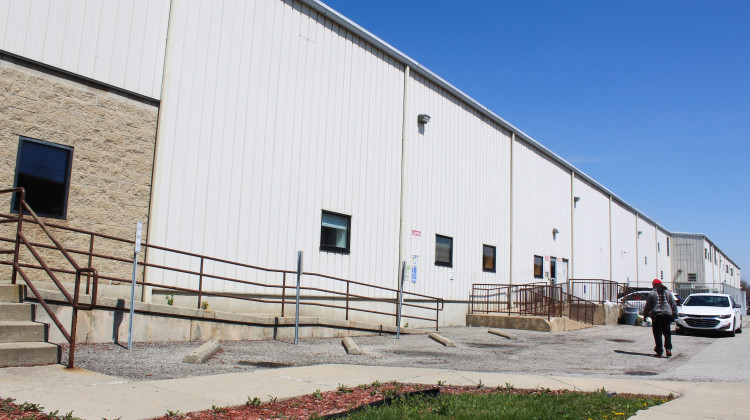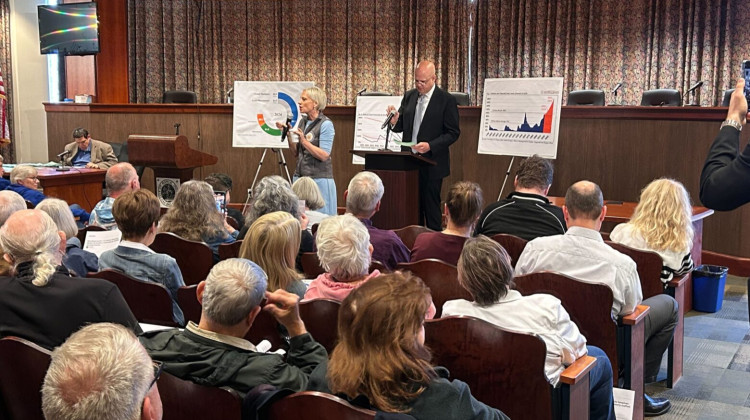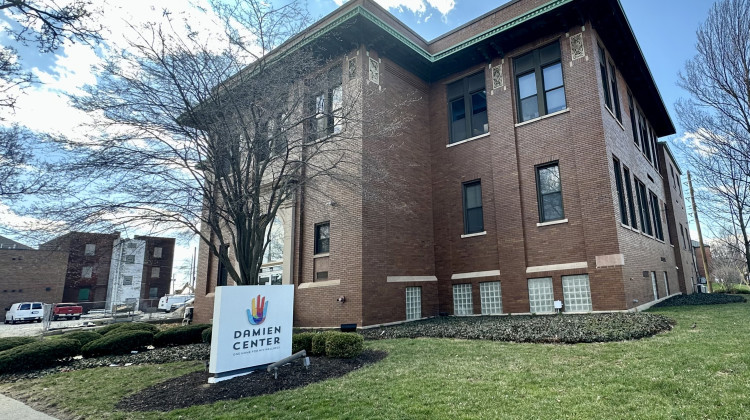
Charlie Cain teaches Internet Basics classes at the Central Branch of the Indianapolis Public Library. The class covers topics such as bookmarking websites, managing cookies and appropriate social media use.
Sydney Dauphinais/WFYIDarlin Martinez works in the computer lab at the Martindale-Brightwood branch of the Indianapolis Public Library. She helps out in the Career Center and teaches computer literacy classes.
Martinez lives in the neighborhood and has built connections with many of the regular patrons.
“I’m kind of fanatical about community,” she said.
She teaches classes like “Introduction to Gmail” and “Microsoft Word.” Most of the regular attendees are seniors learning how to use a computer for the first time.
She said most of them are reentering the workforce – and the job application process looks a lot different today than it did when they left. Instead of turning in a paper application, much of the work is completed online.
“I had a gentleman come in who was applying at the Safeway across the street,” Martinez said. “The [people at Safeway] were like, ‘no, go to the library, get on a computer, make a user, pick our location.’ It was like a million and one steps.”
Martinez said the patron came in to use the library computers to work on his application. It took several days for him to figure out how to navigate the computer and online portal.
“He'd kind of be worn out after an hour and say, ‘I’ve got to come back, I’ve got to step away,’” Martinez said. “I mean, he came in like six or seven times to work on that one application. And it was tough, because he was not comfortable on the computer at all.”
Digital inclusion ensures that people learn the skills they need to navigate an online world. But many people learning these skills don’t own a computer. Even more can’t afford internet at home.
In Marion County, it’s estimated nearly 90,000 households are without a computer and more than 200,000 people live in homes without broadband internet. That’s according to data from The Polis Center at IUPUI.
The same data indicates Black and Hispanic communities disproportionately lack internet and computer access at home. Almost half of all people without a computer in Marion County are Black, even though Black residents make up less than a third of the county's residents.
That’s where the library comes in.
All public libraries in Indianapolis provide free access to computers and the internet when they are open. Marianne McKenzie runs the digital inclusion program at Indy PL and says it is the only way for many to apply for jobs, pay bills, get health care information and attend school.
“And then during the pandemic,” McKenzie said, “we realized that there were people who maybe couldn't make it during our standard business hours, who still needed access to WiFi to do things like complete homework.”
Branches have varying hours, but after hours, people can still access the library Wi-Fi from the parking lot.
“So if you find that… you've got to, you know, upload a resume to a job or complete that homework assignment, there are some options [for getting online] even when the branch is closed,” McKenzie said.
The digital divide is fueled by systemic inequalities
Data from Ball State University indicates disparities in internet access are particularly stark for people already facing socioeconomic disadvantages. It shows single-parent households, households with parents not in the workforce, low-income households and households that do not speak English at home are all far less likely to have internet access.
Research from the Brookings Institute underlines that income disparity. Families earning less than $25,000 a year lack broadband at a rate three times higher than households earning more than $100,000 a year.
Similarly, renters are around 14 percentage points more likely to lack broadband than homeowners.
These demographic disparities deepen the problem, said Nicol Turner-Lee, a researcher with the Brookings Institute.
“It’s still the traditional availability, affordability, digital literacy, but now it's compounded even more,” Turner-Lee said. “Because the people who are on the wrong side of digital opportunity are often the ones that are experiencing a series of systemic inequalities.”
Digital inclusion efforts at the library focus on engagement with disenfranchised communities to figure out what people’s needs are.
McKenzie said addressing gaps in digital literacy is key to addressing larger inequities.
“From the library's perspective, our mission is all around lifelong learning,” she said. “And increasingly, both from grade school, through college and on into lifelong learning, you have to have access to the internet, to engage in that process.”
Michael Hicks, an economics professor at Ball State, said gaps in digital literacy aren’t going away any time soon. Technology progresses at a pace that can leave some people behind if they do not adapt to the changes.
“I wrote a doctoral dissertation using a mainframe computer on a dial-up [internet connection] and I thought the dial-up service was great,” Hicks said. “That was only 25 years ago.”
Hicks pointed out other problems that make it difficult to solve digital inequities. For example, there will likely always be people who can’t afford to pay for the internet at home. There will also always be people who can’t read or write — federal money alone can’t remove these types of barriers.
He said he believes state and local initiatives are most effective in addressing these issues.
“There's no permanent technological solution to this,” Hicks said. “It's going to be an evolving one forever.”
A ‘wealth of opportunity’ to make progress on digital inclusion
Several ongoing efforts are taking place at the federal level to close the digital divide.
The Infrastructure Investment and Jobs Act, which was signed into law last year, includes programs that help households with internet access costs.
It also funds the Digital Equity Act, which offers grant money “to ensure that all people and communities have the skills, technology, and capacity needed to reap the full benefits of our digital economy.”
Most of this federal money gets distributed at the state and local level.
“So there's just this huge wealth of opportunity,” McKenzie said.
The Indianapolis Public Library is a big local player in these initiatives. McKenzie said that’s why it’s working on collaborating with local nonprofits and other organizations that can also help.
“Right now is the time that Indianapolis has to form a group of people sort of pulling in the same direction to address digital inclusion, so that we're prepared to capture that additional funding,” she said.
Contact WFYI economic equity reporter Sydney Dauphinais at sdauphinais@wfyi.org. Follow on Twitter: @syddauphinais.
 DONATE
DONATE






 Support WFYI. We can't do it without you.
Support WFYI. We can't do it without you.